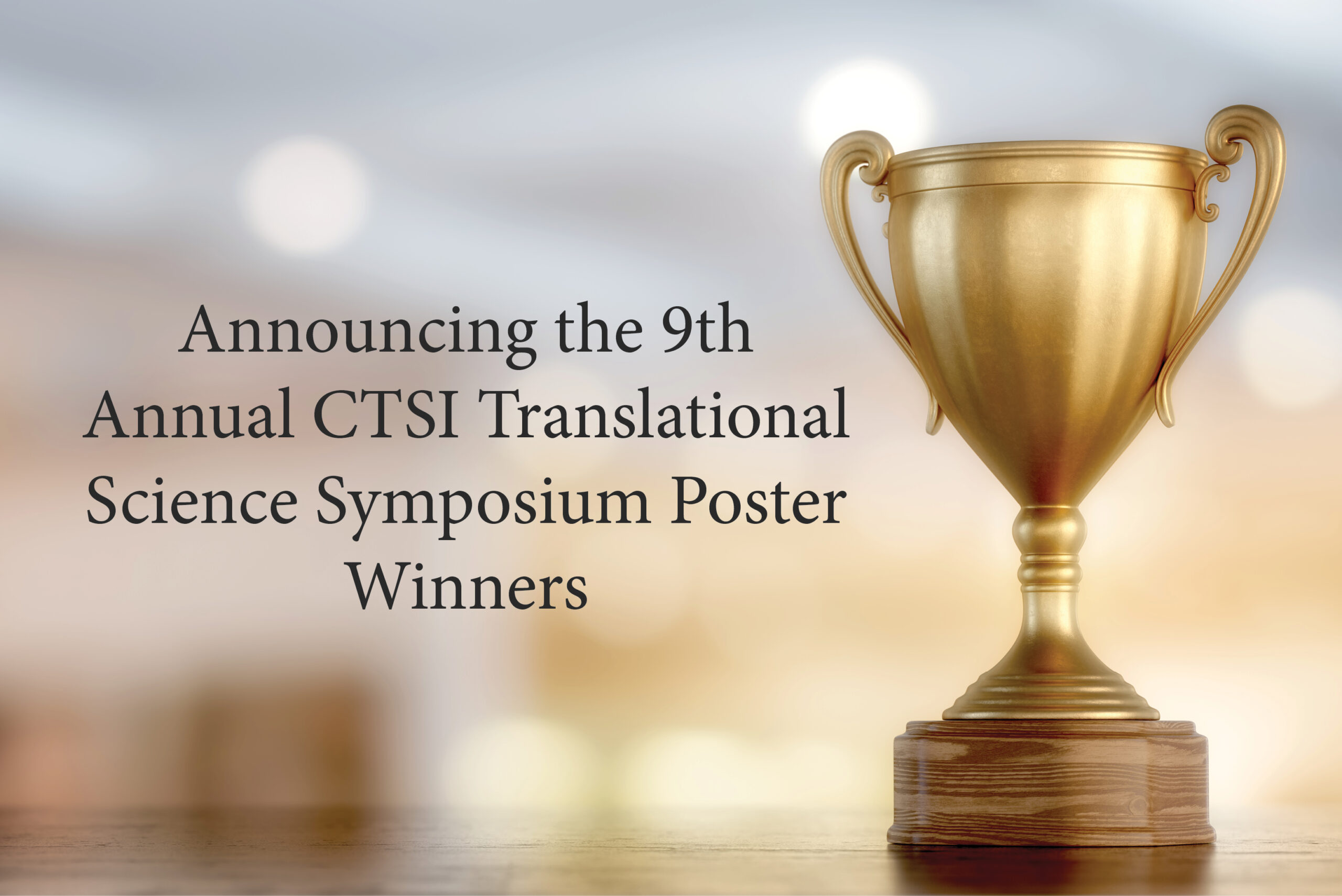Special thanks to all our participants for presenting their posters at the 9th Annual CTSI Translational Science Symposium Poster Session and congratulations to the winners!

First Place: Pregnancy-Related CVD Risk Management in the First Postpartum Year
Approximately 20-30% of pregnancies in the US involve at least one complication that is associated with long-term cardiovascular disease risks, such as preeclampsia, gestational diabetes, or preterm delivery. Such patients are likely to benefit from increased preventive care, including cardiovascular disease risk screening and counseling, beginning within the first postpartum year. But clinical guidance for primary care after complicated pregnancies is limited. The authors conducted a systematic review of US clinical practice recommendations from the past decade, 2010-2020, regarding primary care for patients whose recent pregnancy complications indicate that they may be at increased risk for cardiovascular disease. They identified 13 publications with relevant guidelines. Many of the guidelines were ungraded or based on weak evidence. However, guidelines consistently recommended CVD risk assessment within the first postpartum year, followed by individualized CVD risk counseling and management on an ongoing basis. The authors developed a practical checklist to assist primary care clinicians in practice.

Mara Murray Horwitz is an Assistant Professor of Medicine at Boston University School of Medicine and a primary care physician in the Women’s Health Unit at Boston Medical Center. Her research lies at the intersection of sexual and reproductive health care, and primary care. She is particularly interested in improving primary care after pregnancy complications that are associated with future chronic diseases (e.g. preeclampsia, which is associated with chronic hypertension and cardiovascular disease). Her current work focuses on (1) defining the role of the primary care clinicians in postpartum care, (2) understanding patterns of pregnancy-related cardiovascular disease risk and follow-up, and (3) understanding barriers to preventive care after complicated pregnancies. In the future, she hopes to develop interventions that improve postpartum care coordination and primary care follow-up for BMC patients with elevated chronic disease risks.
Second Place: Quantification of Corneal Collagen Cross-Linking in Keratoconus with IS-OCT
The quantification of corneal collagen crosslinking (CXL) in patients with keratoconus uses a technology called inverse spectroscopic optical coherence tomography (IS-OCT). The optimization of CXL is hindered by the inability to immediately measure treatment effects. IS-OCT is an emerging technique capable of non-invasively detecting nanoscale ultrastructural changes. The IS-OCT output measure was previously found to increase with increased collagen cross-linking in vitro, so we performed a pilot study to measure changes in keratoconus patient eyes before and after CXL by IS-OCT in vivo. We found that IS-OCT can be used to image corneas quickly and non-invasively in patients. The output measure was increased in corneas following CXL, which means that IS-OCT could help quantitate CXL in vivo. We hope that further study with additional patients and methods for improved data normalization will help validate our preliminary results.

Eugene Hsu is currently a second-year medical student at Boston University School of Medicine. She graduated from the University of Washington in 2017 with a BS in bioengineering, where she was first introduced to optical coherence tomography (OCT), after joining Dr. Ruikang Wang’s research lab. Eugene then worked as a research assistant at Massachusetts General Hospital in Dr. Herminia Rosas’ neuroimaging lab, where they studied structural and functional changes in the brains of patients with Huntington’s disease and Downs syndrome adults with Alzheimer’s disease. During her first year of medical school, she joined Dr. Hyunjoo Lee’s and Dr. Ji Yi’s ophthalmology research team to study how inverse spectroscopic OCT can be used to monitor treatment effects of corneal collagen cross-linking in patients with keratoconus.
Second Place: Impact of a Systemwide Incidental Adrenal Mass Quality Improvement Initiative
Dr. Woods’s project involved a quality improvement (QI) initiative focused on improving rates of appropriate follow-up workup after the discovery of an adrenal mass in patients presenting for care for unrelated reasons. The initiative was targeted toward patients’ primary care providers through chart-based reminders, provision of a clinical evaluation algorithm, and introduction of radiology templates that clarified surveillance imaging needs. Compared to a historical group of patients with an approximately 25% rate of adrenal mass workup, those diagnosed during the QI initiative had a 37% rate of workup overall, which was significantly greater. Moreover, there was a nearly 56% follow-up workup rate in the subgroup that successfully received all aspects of the QI initiative, including the radiology template of which uptake was not universal.

Dr. Woods is a current post-doctoral research fellow in the Department of Surgery at Boston University School of Medicine/Boston Medical Center with an additional affiliation with the Division of Surgical Oncology within the Department of Surgery at the Johns Hopkins University School of Medicine. She is broadly interested in surgical outcomes and health services research and has most recently focused on projects related to language disparities and the management of incidental adrenal masses. Prior to her research fellowship, she attended medical school at the State University of New York Downstate College of Medicine. She subsequently completed three years of general surgery residency at Beth Israel Deaconess Medical Center, where she will return after her research fellowship.
Second Place: Investigating CORD GWAS in iPSC-derived Alveolar Epithelial Cells Using CRISPRi
Chronic obstructive pulmonary disease (COPD) is underpinned by genetic susceptibility; however, how genes associated with COPD risk contribute to alveolar epithelial dysfunction is poorly understood. We used CRISPR interference in induced pluripotent stem cell-derived type 2 alveolar epithelial cells (iAT2s) to understand the function of genes of interest. We found that knockdown of genes of interest affected various aspects of AT2 biology, including differentiation, proliferation, and/or surfactant expression.
 Rhiannon Werder is a postdoctoral fellow at the Center for Regenerative Medicine (CReM) at Boston University. Rhiannon completed her Ph.D. at the University of Queensland (Australia). Her research interests lie in the area of epithelial biology and disease modeling. Currently, Rhiannon works on understanding genetic susceptibility in chronic obstructive pulmonary disease using induced pluripotent stem cell models of the lung epithelium.
Rhiannon Werder is a postdoctoral fellow at the Center for Regenerative Medicine (CReM) at Boston University. Rhiannon completed her Ph.D. at the University of Queensland (Australia). Her research interests lie in the area of epithelial biology and disease modeling. Currently, Rhiannon works on understanding genetic susceptibility in chronic obstructive pulmonary disease using induced pluripotent stem cell models of the lung epithelium.